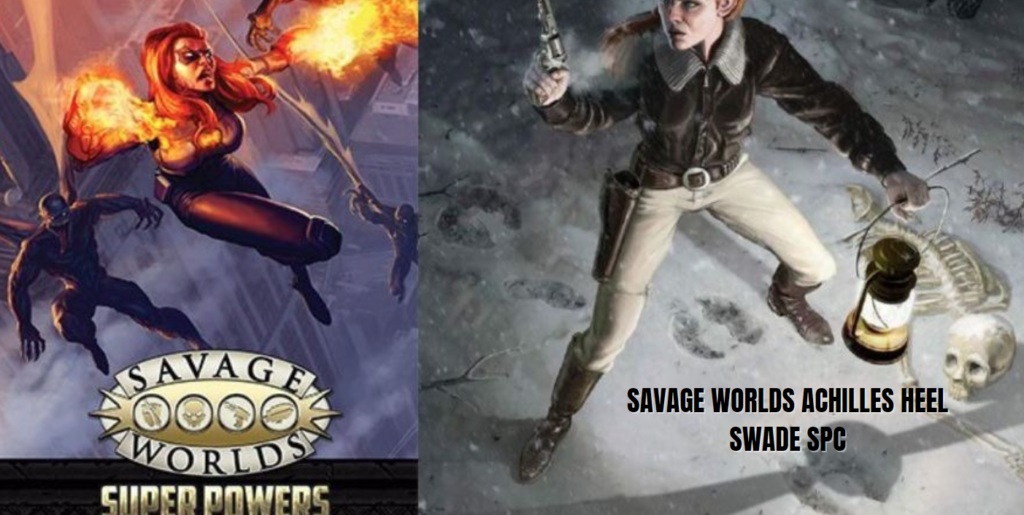The Savage Worlds role-playing system has captured the imagination of tabletop gamers for years due to its streamlined rules, fast-paced gameplay, and versatility. One of the elements that makes this system stand out is its ability to be adapted to various genres, with the Super Powers Companion (SPC) being one of its key supplements.
Within this system, a notable disadvantage or weakness, particularly for characters with superpowers, is the concept of the “Achilles Heel.”
In this comprehensive guide, we will explore the significance of the “Savage Worlds Achilles Heel SWADE SPC” in detail. We’ll break down how it fits into the overall gameplay, how it affects character creation and role-playing, and how you can effectively integrate it into your campaigns.
Our aim is to go beyond existing online information by providing unique analyses, insights, and practical tips for Game Masters (GMs) and players alike.
Introduction to Savage Worlds and the Super Powers Companion (SPC)
Savage Worlds is known for being a universal role-playing system with a focus on “Fast! Furious! Fun!” gameplay. It offers an adaptable set of core rules, allowing players to engage in a variety of genres, from fantasy to science fiction, and superhero settings.
The Super Powers Companion (SPC) supplement for Savage Worlds Adventure Edition (SWADE) is designed to expand the system’s capability to run superheroic campaigns. It introduces powers, mechanics, and various enhancements to create superpowered characters while maintaining balance in gameplay. However, even the mightiest heroes must have some form of vulnerability, which is where the concept of the Achilles Heel comes into play.
Understanding the Achilles Heel in Savage Worlds (SWADE SPC)
In the context of Savage Worlds, an Achilles Heel is a superpowered character’s major weakness. Drawing inspiration from the myth of Achilles, whose only vulnerability was his heel, this mechanic allows for heroes and villains alike to have specific limitations that opponents can exploit.
The Achilles Heel can take many forms. It could be tied to a specific substance (like Kryptonite for Superman), a mental flaw, or even a condition that negates powers under certain circumstances. This weakness balances the powerful abilities a character may possess in the SPC ruleset and creates a more dynamic and engaging narrative for both players and Game Masters (GMs).
The Role of Weaknesses in Character Development
One of the most compelling aspects of role-playing games is the opportunity to develop complex, multifaceted characters. Weaknesses like the Achilles Heel contribute to this depth by forcing players to consider their character’s vulnerabilities alongside their strengths. This adds layers to their backstory, motivations, and the way they approach challenges.
A superpowered character without any weaknesses risks becoming overpowered, which can lessen the tension and excitement in a game. By introducing an Achilles Heel, GMs ensure that even the most powerful characters face moments of peril, driving home the idea that every hero has their limits.
Why the Achilles Heel Matters in Superpowered Campaigns
The Achilles Heel is essential in superhero-themed campaigns because it creates balance. In the world of Savage Worlds, particularly with the Super Powers Companion, characters often wield god-like abilities, making it easy for them to overcome traditional threats. Without some form of limitation, these characters could dominate every scenario, leaving little room for creative problem-solving.
By integrating an Achilles Heel, a GM can introduce situations where the character’s power isn’t always the solution, and players must rely on teamwork, strategy, or role-playing to overcome obstacles. This also provides villains with a potential edge, leading to more suspenseful and unpredictable encounters.
How to Choose an Achilles Heel for Your Character
Choosing the right Achilles Heel for your character is about striking a balance between creating a compelling weakness and maintaining a playable character. Here are some tips for selecting an appropriate Achilles Heel in Savage Worlds SWADE SPC:
- Tie it to the Character’s Powers: Make sure the Achilles Heel is thematically linked to the character’s superpowers. For instance, if your character has fire-based abilities, their Achilles Heel might be extreme cold.
- Consider Story Impact: The Achilles Heel should add to the narrative. If your character’s vulnerability is obscure or rarely comes into play, it won’t be as effective in driving the story forward.
- Keep it Manageable: While the Achilles Heel should present a significant challenge, it shouldn’t make the character unplayable. Make sure it’s a vulnerability that can be worked around or overcome with clever tactics.
- Collaborate with the GM: Work with your GM to ensure that your Achilles Heel fits within the larger framework of the campaign. This will ensure that your character’s weakness doesn’t clash with the game’s overall balance.
Achilles Heel in Practice: Balancing Power with Vulnerability
The Achilles Heel mechanic in Savage Worlds SWADE SPC is a delicate balancing act. Characters with immense power can easily overshadow other party members or trivialize challenges if they are not kept in check by their weaknesses. On the other hand, a well-chosen Achilles Heel introduces drama, role-playing opportunities, and tactical challenges that keep players engaged.
Here’s how the Achilles Heel works in practice:
- Combat Situations: In combat, the Achilles Heel may give enemies a distinct advantage if they exploit the character’s weakness. This forces players to adapt their strategies, relying on teammates or using the environment to their advantage.
- Role-Playing: Outside of combat, the Achilles Heel can be a great tool for role-playing. It might affect how the character interacts with the world or how they approach certain situations. For example, a character whose powers are weakened in the presence of magic might avoid magical areas or allies.
- Campaign Dynamics: GMs can design encounters specifically tailored to test a character’s Achilles Heel, keeping the campaign fresh and engaging. However, these moments should be used sparingly to avoid frustration.
Creative Examples of Achilles Heels in Savage Worlds
Looking for inspiration? Here are some creative examples of Achilles Heels that can be applied to superpowered characters in Savage Worlds SWADE SPC:
- Energy Drain: Your character’s powers are fueled by external energy, and without access to this energy source, their abilities rapidly diminish.
- Elemental Weakness: The character’s powers are negated or even harmed by a specific element, such as water, fire, or electricity.
- Cognitive Overload: Using their powers causes immense mental strain, leading to headaches, memory loss, or even temporary insanity.
- Overexertion: The character can only maintain their powers for a limited time before they suffer physical exhaustion, requiring rest to recharge.
- Dependency: The character is reliant on a substance (such as a serum or artifact) to maintain their powers. Without regular doses, their powers fade.
Game Master Tips for Integrating Achilles Heels into Campaigns
As a GM, it’s crucial to integrate Achilles Heels in a way that enhances gameplay without disrupting the flow of the campaign. Here are some tips to keep in mind:
- Be Fair but Challenging: The Achilles Heel should present a challenge, but it shouldn’t completely undermine the player’s experience. Balance is key.
- Use Achilles Heels to Drive the Plot: Build encounters or story arcs that revolve around a character’s Achilles Heel. This adds depth and personal stakes to the campaign.
- Give Characters Opportunities to Overcome Their Achilles Heel: Allow players to discover ways to mitigate or temporarily bypass their Achilles Heel, such as finding a protective amulet or learning a new ability.
- Encourage Collaboration: Achilles Heels encourage teamwork, as characters may need to rely on their allies to compensate for their vulnerabilities.
Achilles Heel vs. Other Weaknesses in Savage Worlds
While the Achilles Heel is a notable mechanic in Savage Worlds SPC, it’s important to understand how it compares to other types of weaknesses in the system:
- Hindrances: These are general disadvantages that affect a character’s abilities or social interactions. Achilles Heels, by contrast, are typically more focused on negating or weakening a character’s superpowers.
- Powers with Drawbacks: Some powers in SWADE SPC have built-in drawbacks, such as limited range or specific activation conditions. Achilles Heels, however, are broader in scope and often play a larger role in defining the character’s vulnerabilities.
- Environmental Factors: Environmental weaknesses affect all characters equally (e.g., extreme cold). Achilles Heels, however, are unique to individual characters and specifically impact their powers.
Exploring the Strategic Use of Achilles Heel in Combat
Combat in Savage Worlds is known for being fast-paced and tactical. When a character has an Achilles Heel, it introduces an additional layer of strategy:
- Positioning: Characters with a known Achilles Heel may need to position themselves carefully on the battlefield to avoid exposure to their weakness.
- Allies Covering Weaknesses: Team members can compensate for a character’s Achilles Heel by providing support in areas where they are vulnerable.
- GM Tactics: As a GM, you can design encounters where enemies have knowledge of a character’s Achilles Heel and specifically target that weakness. However, balance this by ensuring the player has a chance to counter or mitigate the threat.
Case Studies: Notable Uses of Achilles Heel in Savage Worlds Campaigns
Looking at examples of how other groups have used the Achilles Heel mechanic can provide insight into its versatility:
- Case Study 1: The Super Soldier’s Overexertion: A group ran a campaign where the super soldier character had immense strength but could only maintain it for short bursts. In key battles, this Achilles Heel forced the team to adopt hit-and-run tactics and carefully manage the super soldier’s abilities.
- Case Study 2: The Fire Mage’s Elemental Weakness: In another campaign, a character with fire-based powers had an Achilles Heel that rendered them powerless in the rain. This added a dramatic twist during a climactic battle in a thunderstorm, forcing the player to find creative ways to contribute without their powers.
Player Experience: Handling the Achilles Heel with Fun and Fairness
For players, managing an Achilles Heel can be a challenging but rewarding experience. Here are some tips for handling your Achilles Heel:
- Embrace the Vulnerability: Instead of viewing the Achilles Heel as a limitation, consider it an opportunity to deepen your role-playing. How does your character feel about their weakness? How do they compensate for it in their everyday life?
- Strategize with Your GM: Work with your GM to find ways to incorporate your Achilles Heel into the story in meaningful ways. Don’t be afraid to lean into moments of weakness—they can lead to some of the most memorable role-playing experiences.
- Turn Your Weakness into Strength: Find creative ways to turn your Achilles Heel into a source of strength. Perhaps your character’s vulnerability makes them more cautious, strategic, or resourceful in overcoming challenges.
FAQs About Savage Worlds Achilles Heel SWADE SPC
1. What is an Achilles Heel in Savage Worlds SWADE SPC?
- In Savage Worlds, an Achilles Heel is a specific vulnerability that weakens or negates a character’s superpowers, adding depth and balance to the game.
2. How does the Achilles Heel affect gameplay?
- The Achilles Heel introduces challenges that force players to think strategically and adapt to situations where their character’s powers are limited or negated.
3. Can Achilles Heels be overcome or mitigated?
- Yes, players can work with the GM to discover ways to temporarily mitigate their Achilles Heel, such as acquiring special items or learning new skills.
4. Are Achilles Heels mandatory for characters in SPC?
- While not mandatory, an Achilles Heel adds complexity and balance to superpowered characters, making it a popular choice for many players.
5. What are some common examples of Achilles Heels?
- Common examples include vulnerabilities to specific elements (like water or fire), physical exhaustion from overuse of powers, or reliance on external energy sources.
Conclusion: Enhancing Your Game with Achilles Heel Mechanics
The Savage Worlds Achilles Heel SWADE SPC mechanic provides an exciting opportunity to add depth, strategy, and narrative tension to your game. Whether you’re a player looking to create a balanced, interesting character or a GM seeking ways to challenge your players, the Achilles Heel offers a wealth of possibilities.
By carefully selecting an Achilles Heel and incorporating it into your character’s story and abilities, you create a more dynamic and engaging gameplay experience. Game Masters, in turn, can use this vulnerability to introduce suspense, drama, and memorable moments into their campaigns. Whether you’re running a superhero-themed game or incorporating superpowers into another genre, the Achilles Heel is an essential tool for balancing power and creating rich storytelling opportunities.

















